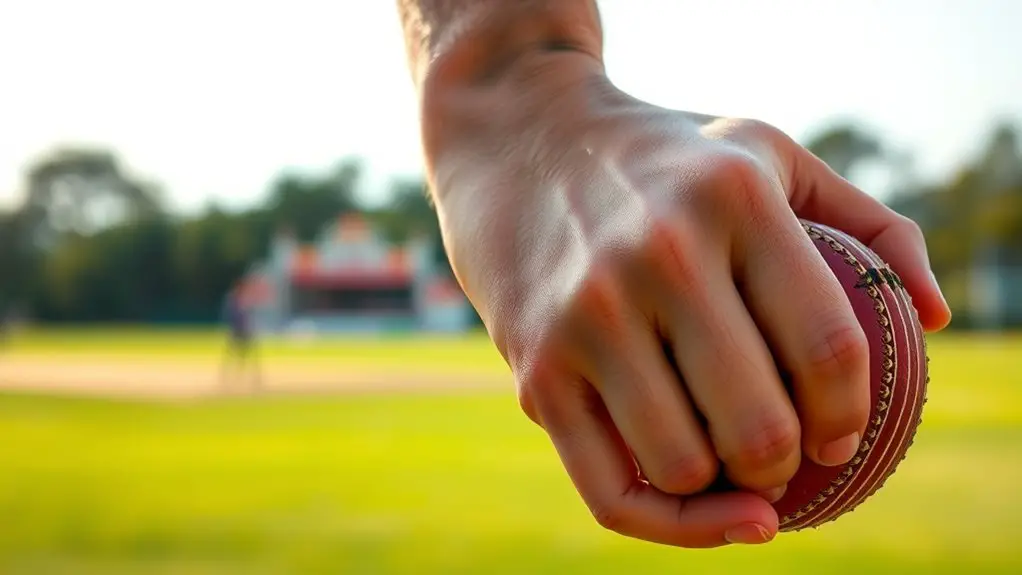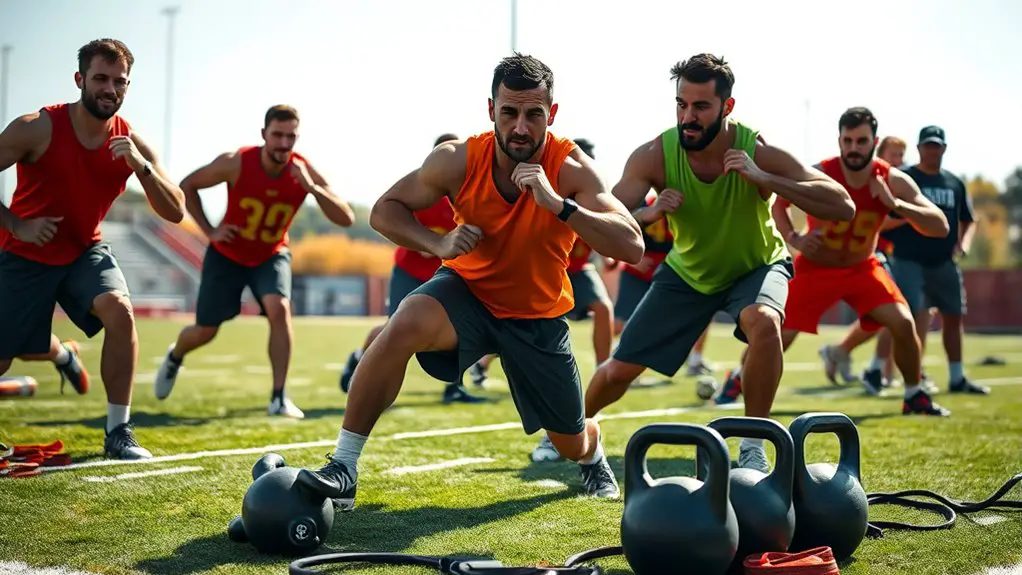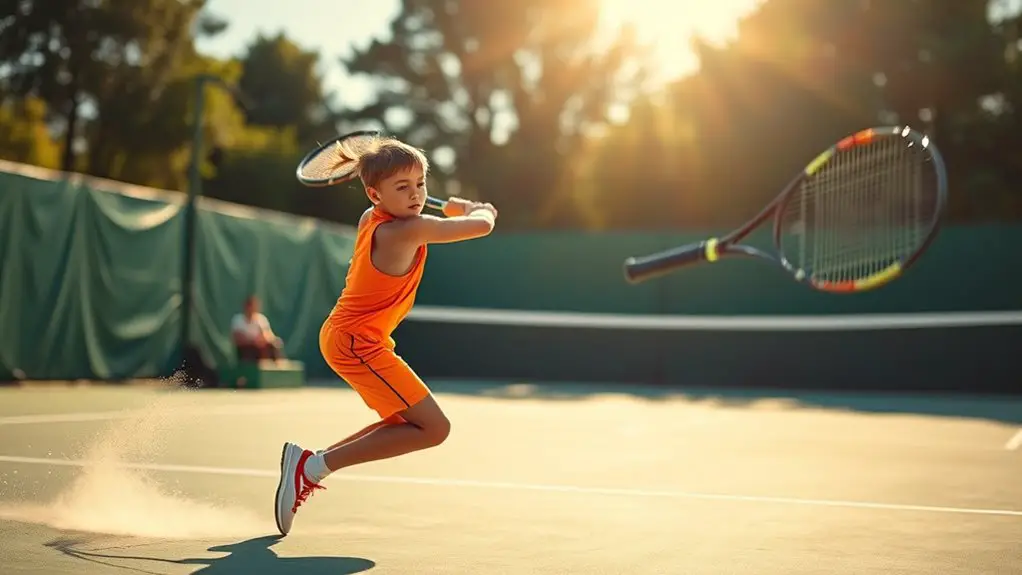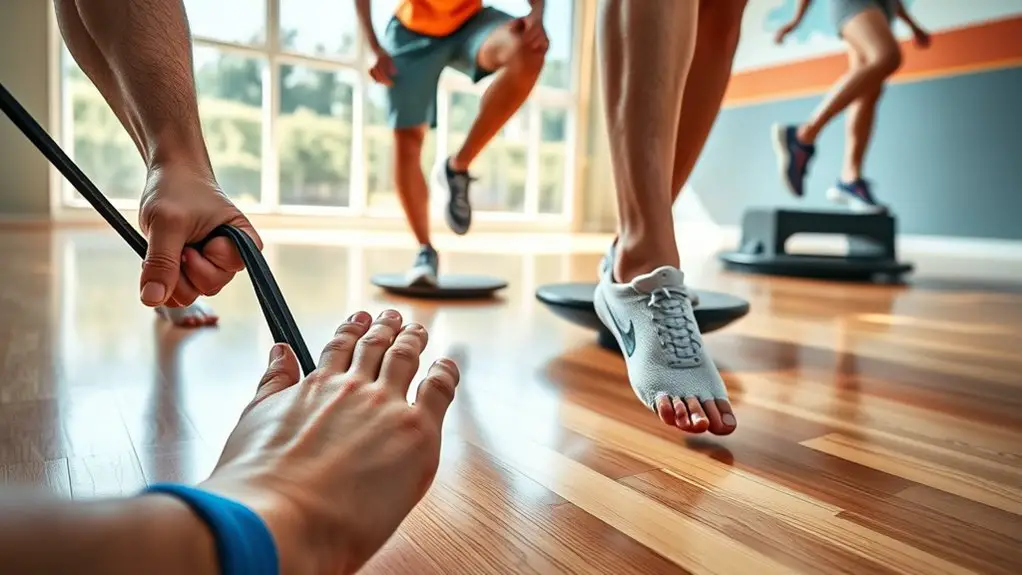Wrist strength is essential for effective spin bowling. It allows you to generate varied spins, vital for confusing batsmen. With a powerful wrist, you can control your deliveries better and increase your bowling accuracy. Flexibility and strength enhance wrist movement, ensuring your spins are unpredictable. Consistent wrist training, alongside proper techniques, can greatly improve your performance. If you want to understand how to sharpen your spin control and learn common pitfalls, there's more to explore.
The Mechanics of Spin Bowling
When you watch a spin bowler in action, you'll notice that the mechanics behind their delivery are fundamental to achieving that elusive turn and bounce. Understanding your wrist anatomy is important; it's not just about arm movement. Your wrist plays a significant role in generating spin variations, allowing you to control the ball's trajectory and behavior on the pitch.
As you grip the ball, the position of your wrist can determine whether you deliver a leg spin, off-spin, or even a doosra. Each spin variation relies on a specific wrist angle and flick at the point of release. You'll want to practice these subtle movements to embrace the freedom of spin bowling fully. With a strong, flexible wrist, you'll be able to unleash your creativity, making each delivery a unique expression of your skills. Prioritizing glute activation can also enhance your overall athleticism, providing you with better stability and power in your bowling technique. So, embrace the mechanics and let your wrist guide you to spin success!
Role of the Wrist in Spin Delivery
The wrist plays an essential role in spin delivery, with even a slight adjustment making a significant difference in the ball's behavior. Good wrist flexibility allows you to create more spin variation, which can baffle batsmen and keep them guessing. When you flick your wrist at just the right moment, you reveal the potential of different spins—be it top spin, leg spin, or off spin.
Mastering the wrist's movement isn't just about raw strength; it's about finesse and control. You're aiming to manipulate the ball's rotation and trajectory, enhancing its effectiveness. A flexible wrist can mean the difference between a predictable delivery and one that spins sharply, catching your opponent off guard. So, focus on your wrist's role in your technique. Embrace that freedom of movement, and you'll find your spin bowling game elevating to new heights.
Exercises to Enhance Wrist Strength
To improve your wrist strength for spin bowling, you'll want to focus on specific exercises that target this area. Wrist flexion exercises, resistance band workouts, and grip strength training are all effective methods. Incorporating these into your routine can lead to better control and spin on the ball.
Wrist Flexion Exercises
While wrist strength is essential for effective spin bowling, incorporating wrist flexion exercises into your training can greatly enhance your performance. These exercises improve wrist mobility and help develop the flexibility needed for spin bowling. Try simple movements like wrist curls with a lightweight or even just your own body weight. Start by flexing your wrist upward, then lower it back down slowly. You can also practice extending your wrist while holding a light object. This kind of flexibility training not only strengthens your wrist but also increases control over your spin. Remember, the more you focus on these exercises, the better your wrist strength and overall bowling technique will become. Enjoy the journey of improving your game!
Resistance Band Workouts
Although many players focus on traditional strength training, incorporating resistance band workouts can greatly boost your wrist strength for spin bowling. These exercises provide band resistance that targets the wrist muscles effectively, enhancing both strength and wrist flexibility.
Start with wrist curls: anchor the band under your foot and curl your wrist upward against the resistance. Next, try wrist rotations by holding the band with both hands, rotating your wrists in and out. This movement helps improve your range of motion.
Finally, consider lateral raises for wrist stability. Attach the band to a stable surface, hold it with your wrist straight, and raise your arm to the side against the band resistance. Regularly practicing these workouts will empower your spin bowling game, letting you release your full potential.
Grip Strength Training
Building on resistance band workouts, grip strength training is another essential component in enhancing your wrist strength for spin bowling. By focusing on grip variations, you can develop the necessary muscle control and endurance needed for effective spin delivery. Exercises like squeezing a stress ball or using hand grippers can greatly improve your grip mechanics. You might also try towel wringing to increase wrist flexibility and strength simultaneously. Incorporate these exercises into your routine, gradually increasing resistance to challenge yourself. Remember, the stronger your grip, the better your control over the ball, allowing you to express your unique spin style. Embrace this freedom in your training, knowing that each rep brings you closer to mastering your craft.
Techniques for Improving Spin Control
To improve your spin control, you'll want to focus on wrist positioning techniques that enhance your delivery. Combining these with specific strengthening exercises and practice drills can make a noticeable difference in your performance. Let's explore how each of these elements contributes to mastering spin bowling.
Wrist Positioning Techniques
Wrist positioning is essential for mastering spin control in bowling. To enhance your wrist rotation and flexibility, practice various techniques that focus on the wrist's role in spin. Here's a simple guide to help you fine-tune your skills:
| Technique | Description | Benefits |
|---|---|---|
| Wrist Snap | Quick flick of the wrist | Increases spin and speed |
| Finger Spin | Use fingers to impart spin | Boosts control and accuracy |
| Relaxed Grip | Maintain a loose hold | Enhances wrist flexibility |
Try integrating these techniques into your practice. You'll find that a well-positioned wrist not only elevates your game but also gives you the freedom to express your unique bowling style. Keep experimenting!
Strengthening Exercises
While mastering wrist positioning is essential, incorporating strengthening exercises can greatly enhance your spin control. Building wrist stability and rotational strength will boost your performance on the field. Here are four effective exercises to get you started:
- Wrist Curls: Use a light dumbbell to perform wrist curls, focusing on controlled movements.
- Rotational Twists: Hold a lightweight object, rotate your wrist in both directions to improve flexibility.
- Resistance Bands: Attach a band to a fixed point and perform wrist flexion and extension, enhancing stability.
- Tennis Ball Squeeze: Squeeze a tennis ball to strengthen your grip and wrist muscles.
Incorporating these exercises into your routine will empower your spin bowling, giving you the freedom to express your unique style.
Practice Drills
Improving your spin control requires consistent practice with targeted drills that focus on technique and precision. By honing your wrist stability, you'll enhance your spin accuracy, allowing you to control the ball more effectively. Here are some drills to try:
| Drill Name | Focus Area | Tips |
|---|---|---|
| Wrist Flicks | Wrist Stability | Keep your wrist loose; flick the ball with minimal arm movement. |
| Target Bowling | Spin Accuracy | Aim for specific targets; adjust your grip based on results. |
| Spin Variation | Technique | Experiment with different spins; observe how wrist position affects trajectory. |
| Follow-Through Drill | Mechanics | verify your follow-through aligns with your target; maintain wrist stability. |
| Mirror Practice | Visualization | Watch your form in a mirror; make adjustments to enhance spin control. |
Enjoy the freedom of exploring your unique spin style!
Common Mistakes in Spin Bowling Techniques
Many bowlers often overlook the importance of proper technique when it comes to spin bowling, leading to common mistakes that can hinder performance. To elevate your game, watch out for these pitfalls:
- Neglecting Wrist Position: Failing to maintain a strong wrist can result in ineffective spins and increased risk of wrist injuries.
- Inconsistent Grip: A shaky grip can lead to unpredictable deliveries. Find what feels right for you and stick with it!
- Overcomplicating Spin: Many believe spin bowling is all about wrist flicks, but this is a common misconception. Focus on your entire arm motion.
- Ignoring Follow-Through: Stopping abruptly after delivery can diminish spin and cause injuries. A smooth follow-through is essential for control. Additionally, understanding the importance of flexibility training can help improve wrist mobility and reduce the risk of injuries.
Real-Life Examples of Successful Spin Bowlers
Understanding common mistakes in spin bowling can help you appreciate the skills of successful bowlers around the world. Take legendary spinners like Shane Warne and Muttiah Muralitharan. They didn't just rely on talent; their wrist strength was essential in delivering those magical deliveries that baffled batsmen. You might've heard personal anecdotes about how Warne practiced his wrist flicks for hours, fine-tuning his leg spin. Similarly, Muralitharan's unique action, influenced by his wrist flexibility, made him a nightmare for opponents.
When you see these bowlers in action, it's clear they mastered their craft through dedication and an understanding of their body mechanics. Their journeys remind us that success in spin bowling isn't just about the spin; it's about the strength and control in your wrist. So, take notes from these legends and embrace the freedom to experiment with your technique!
Frequently Asked Questions
How Does Wrist Strength Impact Overall Bowling Performance?
Wrist strength plays an essential role in your overall bowling performance. When you've got good wrist flexibility, you can generate better spin and control. This flexibility enhances your bowling accuracy, allowing you to hit your targets with precision. If your wrist isn't strong enough, you might struggle to maintain that control, leading to inconsistent results. So, focusing on strengthening your wrist can really elevate your game and give you the freedom to express your style.
What Age Should Players Start Focusing on Wrist Strength?
When it comes to wrist strength, you should start focusing on it during your youth training, ideally around ages 10 to 12. This age is perfect for developing the necessary strength and flexibility without risking injury. It's all about building a strong foundation, so you can enjoy the freedom of playing with confidence. As you progress, incorporating wrist exercises will enhance your overall skills and performance, making the game even more enjoyable.
Can Wrist Injuries Affect Spin Bowling Effectiveness?
You might think wrist injuries aren't that big of a deal, but they can seriously impact your bowling effectiveness. When your wrist's compromised, it reduces your ability to control the spin and accuracy of your deliveries. This limitation can mess with your rhythm, making it harder to execute those precise spins you love. So, keeping your wrist strong and healthy is essential for maintaining that freedom and finesse in your bowling style.
How Often Should Wrist Strength Exercises Be Performed?
When it comes to wrist exercise frequency, you should aim for at least three times a week. Consistency is key, so incorporating strengthening routines into your regular workout will help improve your wrist's resilience. You don't have to spend hours—just 15-20 minutes each session can make a big difference. Remember, it's all about finding a routine that fits your lifestyle while giving your wrists the strength they need to thrive!
What Common Injuries Are Associated With Weak Wrist Muscles?
When you've got weak wrist muscles, you're more susceptible to wrist injuries like sprains or tendinitis. These can really hinder your performance and limit your freedom on the field. If you experience such injuries, it's essential to explore rehabilitation techniques that focus on strengthening and flexibility. You'll want to incorporate specific exercises into your routine, so you can bounce back stronger and enjoy your game without the nagging worry of injury holding you back.




